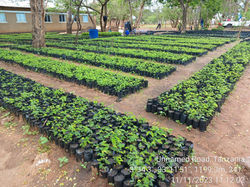

Planting and Caring for Trees is Possible in Shinyanga District
OPE is venturing on this as a result of confirmation of a magnitude of problems that are circulated around the ecosystems and watersheds of the Shinyanga District Council and experiencing an extensive process of degradation and deforestation. Extensive degradation and deforestation of the ecosystems and watersheds of SHINYANGA are attributed to factors related to:
Population growth
Land use change
Poor land management practices
Unsustainable harvesting of natural resources
Migration
Declining commodity prices and climate change
All these leading to dramatic changes to the landscapes. This has necessitated clearing of natural trees and other shade trees, without replacing the tree based system with equivalent to soil fertility management systems. Thus, soil was left bare for longer periods with consequent run-off and siltation.
OPE is complying with and ensuring the Objectives of the National Climate Change Response Strategy 2021 - 2026 are aligned with our Planting trees initiative. The planting trees/reforestation project aims to restore about 67,000 hectares by planting 650,000 trees in Shinyanga District Council. Our key objective is by 2030, ensure sustainable food production systems and implement resilient agricultural practices that increase productivity and production, that help maintain ecosystems, that strengthen capacity for adaptation to climate change, extreme weather, drought, flooding and other disasters and that progressively improve land and soil quality. The interventions will improve the land ecosystems condition, through agroforestry and tree planting hence more biomass leading to an improved rain water infiltration by reducing surface run off, there by increased soil water storage, more water will be available for plants which finally will improve crop plants productivity and yield. The main objective is to promote Sustainable Land Management through policy influencing and tree planting through agroforestry, thus providing basis for economic development, food security and sustainable livelihoods while restoring the ecological integrity of Shinyanga region.

One of our OPE staff Mr. Laurent posed with Ng’hama Village Development Committee after the inception meeting.

Members of Pandagichiza Village Development Committee stand outside the Village Executive Office after the inception meeting.

Small scale farmers, tree planting awareness committee and Ng’hama Primary School tree nursery member are listening careful from TFS staff on preparation of top soil and manure before potting to the poly bags.

Ng’hama Primary School tree nursery in Progress
 Mwamakaranga Primary School tree Nursery |  Mwamakaranga Primary School Nursery |
|---|---|
 Ng'hama Primary School Tree Nursery |  Ng'hama Primary School Tree Nursery |
 Ng'hama Primary School Tree Nursery |  Ng'hama Tree Nursery |
 Acacia nilotica seedlings |  Acacia nilotica seedlings |
 Albizia lebbeck seedlings |  Ng'hama Tree Nursery |
Planting trees
The trees are planted in an agroforestry layout, meaning widely spaced to allow for intercropping with food crops such as cassava, lentils (pulses), corn (maize) and others. In this way farmers are not deprived of agricultural land and the trees get “free” weeding. Also, no thinning’s are required, which avoid cutting of small-diameter trees that have negligible monetary value on the market.
 mwamadelana village |  Mwalukwa village |
|---|---|
 Mwalukwa village |  Ng'hama primary school |
 Mishepo Village |  Shilabela Village |
 Shilabela village |  Sayu village |
 Pandagichiza village |  Nyamalogo village |